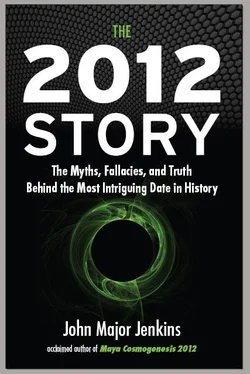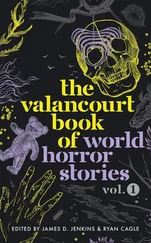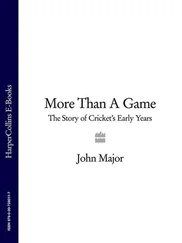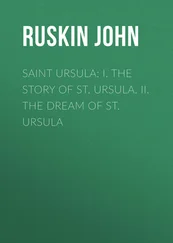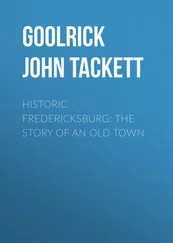The specific issues around the 2012 date are compounded by the fact that the Long Count was historically lost, although, as I’ve emphasized, cycle-ending traditions of renewal are very much alive and well. In the ideological mess that 2012 has become, opinionated assertions are mixed with spiritual truths and philosophical doctrines. Not least of the issues has been my reconstruction of the origins of the 2012 cosmology at Izapa. The modern Maya may find it unusual, strange, and even irrelevant to their concerns, even if it is true. My hope is that a space of reconciliation and unified vision can be achieved between my work and the leaders in the Maya renaissance. Beyond that small concern is the larger issue of the reconciliation of the Western and Indigenous minds. The value systems connected with these two mind-sets are in many ways diametrically opposed. I believe the pathway through to a healthy and sustainable future, for the world at large, is not for the indigenous mind to adapt itself to Western values. That results in the same problem of trying to fit the vast vision of ancient metaphysical wisdom into the small box of materialist science—it can’t work that way. The only way that unification can happen is for the Western paradigm to revive its own “indigenous” wisdom, which we could call “original mind” or even “buddhi mind.” In this regard I am inspired by the words of Don Rigoberto:
In a passage from the sacred book Pop Wuj, in one of the lines it says, “nor are they condemned by justice.” When it speaks and says this, they are making a prophecy that there was going to be a Western judgment against the Maya; this is a reality. Today the laws of the Americas are foreign to the Maya cosmovision. These laws are violating the legitimate rights of the Maya. Another interpretation enters in that the ideological power of the West in its entirety might expire forever in 2012. “As long as the sun walks, as long as there is light, our existence will never be lost.” Thus says the passage in the sacred Pop Wuj [ The Popol Vuh ]. 25
Don Rigoberto performed a ceremony on the final day of the conference in Antigua. We were to have an informal gathering to discuss issues pertaining to the conference. There had been an expression of some bad feeling around the Western appropriation of 2012, around big-money Hollywood movies, and around conferences excluding the Maya voice. The Antigua conference itself, however, was designed as a free event; no profits were made and, in addition to my presentation on Izapa and one by Georgeann Johnson on the participatory function of the Maya ballgame, three delegations of Maya spiritual guides were hosted at the nearby Concepcion guesthouse and presented their views to the audience of close to a thousand attendees at the conference. It was, overall, a great success. Thirteen people showed up for Don Rigoberto’s fire ritual, and as with all rituals of renewal the theme was about sacrificing or letting go of negative thoughts, feelings, and energy. This was an enactment of the fire transformation of cycle endings—throw the illusion into the fire! 26
Maya voices include political leaders, spiritual guides, as well as more philosophical writers in Maya traditions. Robert Sitler is currently translating the work of Gaspar Pedro González, who emphasizes that an important voice for the modern Maya is the ancient book The Popol Vuh . In his book El 13 B’aktun , 27he emphasizes the same reading that I have made of The Popol Vuh , piercing into the archetypal level of meaning: At the end of the cycle, self-serving egoism (Seven Macaw and the Lords of Darkness) must be transformed into a new being of light and consciousness (One Hunahpu as unitary mind). González writes:
From the perspective of contemporary Maya, 2012 constitutes a very important point in the history of humanity since time is a variable that greatly influences the life of the planet and everything that exists on it. Human beings do not exist by coincidence or by a work of chance. They are part of a plan to carry out a mission in this part of the universe. The world is still not totally finished in its creation and perfection; this human creature has a role to play in the world and its preservation. One could say that the life of the planet depends on human beings and what they do in their existence. 28
González publishes from within the Maya context and his life experiences that began in Xibalba, the archetypal Maya underworld, alongside the Ajtxum, the spiritual guides, who preserve authentic Maya identity. I see him as a Maya philosopher who offers both well-reasoned research and insights into Maya teachings presented in the genre of allegorical fiction. Often it is the latter medium that is more effective than nonfiction research in conveying profound truths.
It must be said that, not surprisingly, there are other alleged Maya leaders who are more showmen than shamans. The fact is that you are going to get this anywhere. All statements and work must be assessed with discernment. We often expect prophecy to be about time-stamped visions of specific events that “will happen.” This is the cartoon version of prophecy. I believe that prophecy is best understood as an evocation, an ecstatic calling into being, of the highest possible outcome. This is the role of a true prophet. Of course, there are “dark prophets” (as there are also “dark shamans” or “black magicians”) who will try to call into being with their apocalyptic nihilism the darkest possible future. It is good to be aware of possible worst-case scenarios, but we should not pour our energy into envisioning them and projecting them into manifestation with our fears.
THE MAYA RENAISSANCE WRIT LARGE
Agreat undercurrent is at work in the Maya renaissance that 2012 is shining a light on: We are still trying to work out the integration of Western and Indian modes of being. This is not really Occidental versus Oriental, as two exclusive opposites on equal footing. Ideally, that makes for a nice symmetry, but it isn’t really the way it works. The fact is that the Western mind comes from the more shortsighted and limited perspective of self-interest. It sees the foreground, the details, and can manipulate things with great advantage. Said bluntly, it is stuck in a narcissistic and adolescent phase of psychological development. The Indian mind, or indigenous mind, perceives the entire underlying gestalt, the big picture, and is oriented more toward the good of the whole and maintaining balance with a sustainable value system. As you can see, these two minds are not on equal footing. This isn’t about an “East-meets-West” dialectic. It’s more of a lower mind (irrationalist/ego-based) versus higher mind (transrational original mind , Dreamtime mind, heart-mind, whole-consciousness mind). Again, it’s Seven Macaw versus One Hunahpu.
This is not meant to denigrate the Western mind, although I tend to emphasize its failings precisely because it is so oblivious to taking responsibility for the ecological, political, and economic crises of the modern world that it has spawned. Lost in consumerism and the pursuit of personal gain, the Western life philosophy is acutely developed in the United States of America. Hollywood and the cult of personality are egregious expressions of this state of affairs. In this, something has gone terribly wrong, because the high ideals upon which the United States was founded did not have this scenario in mind. “Life, liberty, and the pursuit of happiness” were meant to empower the individual for Self-actualization (capital S in the Jungian sense, in contrast to the lowercase s used when “self” is synonymous with the ego). The spiritual component of this was not hidden behind a mandate requiring the separation of church and state, but was encouraged by that separation! The church was not to meddle in the worship of ethical freethinkers. Today, America is dealing with many of the same problems that the founding fathers struggled with. They are all issues resulting from the ego’s desire to control—to control people (slavery), resources (global capitalism), and nature for personal gain.
Читать дальше
